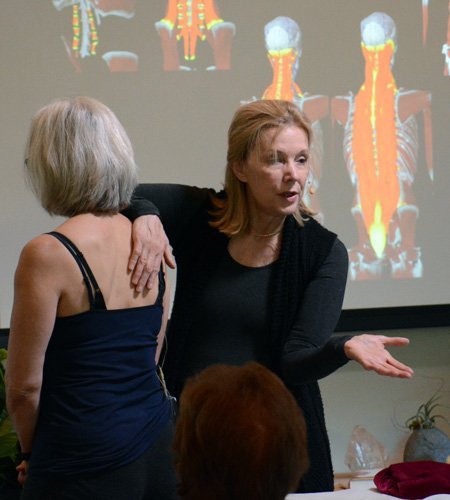In support of integrating talk and touch
There seems to be an unspoken agreement that psychologists and psychotherapists have a higher ranking in the world of healing than do bodyworkers. As a bodyworker who has studied the art and science of touch, bodywork, and movement for over 26 years, this hierarchy seems prejudiced, and at times even borders on microaggression.
This is not to say that I haven’t received wonderful support from the psychotherapists with whom I work collaboratively. I greatly appreciate their knowledge, and they have been open and appreciative of my expertise. What I am addressing here is why, in the many places where I have worked, my input as a bodyworker was, and still is, not deemed important enough to be included in the development of a client’s treatment plan.
When is bodywork psychological, and psychology embodied?
When psychotherapists learn touch skills, should we consider them to be bodyworkers, or are they psychotherapists who touch? When bodyworkers learn to talk with their clients, should we consider them to be therapists, or bodyworkers who are psychologically informed?
I found psychotherapy extraordinarily useful to understand developmental and attachment patterns that repeat in adult relationships. However, I also found that trying to make permanent changes by focusing exclusively on top-down thinking can be a futile pursuit.
In 2001, my colleague Ariel Giarretto, now faculty for SETI, recommended I train in Somatic Experiencing®. Eager to heal, I signed up, and at the same time continued my individual therapy with a non-SE PsyD, with whom my attachment deepened. The Somatic Experiencing training has always brought bodyworkers and psychotherapists together. In spite of significant concerns expressed over the years, Dr. Peter Levine has insisted that bodyworkers and psychologists be trained together. Touch and psychotherapy have long been considered separate modalities, and Peter Levine has been a courageous pioneer in fostering healthy exchange between these professions
During my SE Intermediate training with Dr. Raja Selvam, I was inspired by his teaching and became convinced I wanted to be a psychotherapist rather than an Esalen massage therapist. Raja’s advice was simple and direct: “No, you don’t want to be a psychotherapist; there are too many MFTs. Just be a good bodyworker!” Thus, I embarked on a journey to integrate bodywork, Somatic Experiencing, and the interplay of psychological, physiological, and emotional trauma healing. I studied Ortho Bionomy, Bodynamics, Craniosacral Therapy, Ashtanga and Thai yoga, and post-advanced SE. Kathy Kain became my primary mentor as she developed her Touch for Psychotherapists and Resilient Child workshops. However, for as long as I have been in the SE community, it seems that the focus has been on the ethics of touch for psychotherapists. It has not sufficiently addressed the many issues that SEP bodyworkers, like me, encounter.
Integrating Touch, Bodywork, and Psychotherapy
When I met Dr. Aline LaPierre back in 2003, I had no idea that she would later take up the challenge of bridging the world of touch and talk together, and go on to develop the NeuroAffective Touch® model. Aline is both a psychotherapist and bodyworker, and NATouch™ delves deeply into the issues of what bodyworkers and psychotherapists need to know in order to safely integrate the dynamic worlds of psyche and body. Integrating them seems obvious, but is often awkward and not so easily accomplished. No one, until I met Aline, had focused on the dynamic, subtle, and profoundly healing dance between touch, emotions, cognitions, and talk. In service of mind-body collaboration, the NeuroAffective Touch model holds that words and touch are of equal importance in healing the relationship between mind and heart, brain and body.
It is well known that touch is a primal and biologically essential requirement for the formation of a physically and emotionally healthy human being. Neglected babies who are not touched often die. Touch is a vital, critical component for the formation of identity and ego. Of equal importance to touch and holding are the caregiver’s prosody and facial expressions. Attuned touch, holding, prosody, and facial expressions are the very seeds of the touch and talk connection.
The gift of Stephen Porges’ polyvagal theory is that it emphasizes the important connection between talk, touch, and the social engagement system. The coordination of the muscles and nerves that allow an infant to suck, swallow, and breathe, while being safely held in a caregiver’s arms, develop into our social engagement system. This speaks to the underlying foundational importance of touch. To stimulate the polyvagal system by vibrating the vocal cords, while attending to the client in relational intimacy by way of attuned touch, sends a message of safety to the brain ― it stimulates brain activity and heightens the awareness of self while in relation to a safe other.
For clients whose developmental experience of touch was misattuned, neglectful, or abusive, touch-informed practitioners provide the missing sensations and physical support that speak directly to the nervous system. They use touch to add the missing bodily connection necessary to create a complete mind-body corrective experience. Psychologist Rick Hanson, whose work focuses on rewiring the brain’s negativity bias, teaches that new neural pathways are formed when we hold a positive experience a minimum of 10 seconds at a time. Because touch works directly with Hebb’s neurological principle that "neurons that fire together, wire together," providing positive touch experiences stimulates missing neural connections, and, with repetition, further strengthens these connections.
A client’s brain and body aren’t thinking: "This person is a bodyworker, not a psychotherapist" or "This bodyworker is talking like a psychotherapist." A client, like an infant in survival need, simply longs to be seen, heard, and held. It is the relationship with the caregiver that fuels healthy development and healing. This can happen with either a psychotherapist or a bodyworker, but it is best when the two are integrated ― when bodywork is psychological, and when the psychological is embodied.
What has become clear to me over the years is that healing developmental relational trauma sometimes requires attuned talk with touch, and at other times requires attuned touch with talk. Psychotherapists tend to underestimate the skills of bodyworkers, and bodyworkers tend to feel intimidated by psychotherapists. I know I was. We have so much to learn from one another by listening to each others’ knowledge, and by working collaboratively to expand our points of view.
Laura Melton, CATCi, CMP, SEP has worked in the field of pain management, stress, and self-regulation for 26 years. She is a bodyworker, Somatic Experiencing® Practitioner, certified NARM therapist, and graduate of Pierce College in Addiction Studies. Since 2001, Laura has been a Teaching Assistant to Dr. Peter Levine. She is an approved SE session and consultation provider at all levels of training. She is Executive Assistant of the NeuroAffective Touch® Institute and Lead Teaching Assistant to Dr. Aline LaPierre. Laura maintains a private practice in Beverly Hills.










Hi Maria, I am so glad you found us! The NeuroAffective Touch Institute trains professional mental health practitioners and bodyworkers so that they can offer our approach to an increasing number of individuals who are seeking mindbody integration. We have a growing list of excellent therapists on the Find A Practitioner section of our website. A great number of NATouch practitioners are also SE® trained and we support and appreciate Peter Levine’s work. In fact, I interviewed Peter for the latest issue of the International Body Psychotherapy Journal (IBPJ). He was lovely and so open!
Your work of gathering mindbody resources is very needed. Let us know if we can be of help. Aline
Thank you for your article! This connection is so important. I’m working on creating a list of mindbody approaches to healing chronic pain for my website (www.helaingfromchronicpain.com) and while I’m very familiar with SE®, I hadn’t seen anything about NeuroAffective Touch® before. Would you say this is more for training practitioners, or is it considered a treatment modality that clients can request? Thank you very much.
Hello, thanks for posting this. I am originally trained as a Chiropractor, biodynamic craniosacral therapist and certified teacher. I want to do some Somatic trauma training and would like your opinion on what/ who to study with. NARM keeps coming up as well as neuroaffective touch. I am enrolled in Myrna Martin’s pre and perinatal training, but want to do something only as that was postponed. Any advice would be great, I don’t want to do so many trainings as you have…you have taken all the ones I am interested in…
Thanks in advance for your advice!
Aline’s NATouch training masterfully teaches the delicate integration of mind, body, emotion, and cognition to inform relational therapeutic interventions that punctuate unmet early experiences. In NATouch, compassionately tending to the body’s story together with the mind’s narrative, brings profound healing. In this work, words are as crucial to the mind as attentive attuned touch is to the body. The experience of welcomed existence is critical for little ones and continues to be essential to the adult self throughout life. The NATouch knowledge base and training combine preverbal developmental attachment and trauma work with a therapeutic approach grounded in psychodynamic tradition and affective neuroscience. It also draws from many bodywork approaches and the innovative work of movement educators. The training supports learning that is both personal and professional, tender and impactful, energetic, psychological, and honoring of bio-physiological science.
Excellent! I totally agree with you. Touch is as an essential part of the healing process as is lack of touch an integral part of the process if creation of illness. While your focus in your article is touch and psychotherapy, there is an other significant aspect of what I call the Wellness–> Stress—> Illness—> Healing Process/Mechanism your article brings up for me, touch, words, actions, beliefs and the creation of illness, physical, mental, emotional and spiritual illness. The set of events, conditions and effects mediated through our Stress Response Mechanism and Healing Systems wherein Touch (also words, often within our head, what we think and say to ourselves) is also a major and vital component.
Good morning Allan,
Thank you for your supportive response and feedback. I completely agree with you. The mind is a powerful healer as well as an abuser and can turn on biological survival chemistry and cause dis-ease as well as turn on the bodies powerful pharmacy that support health, healing, and wellbeing. Touch is as necessary to the body as words are to the mind!